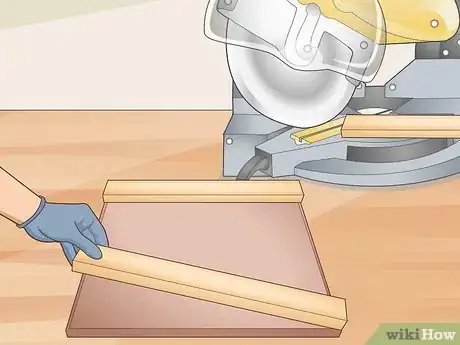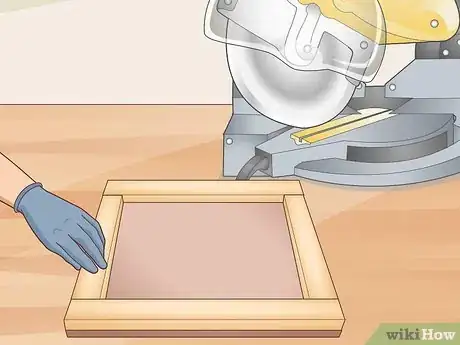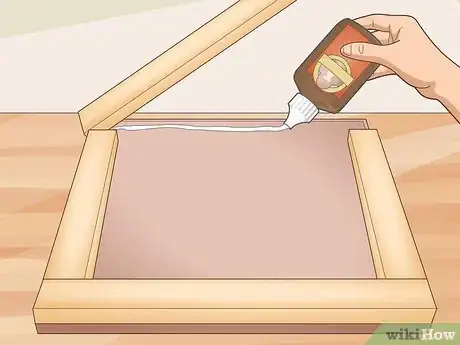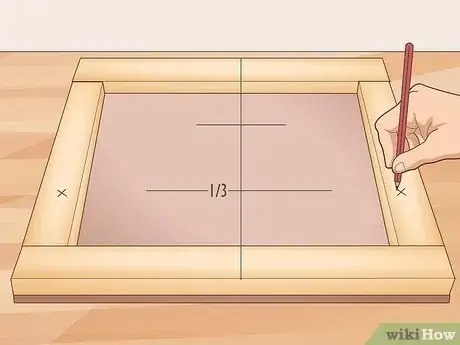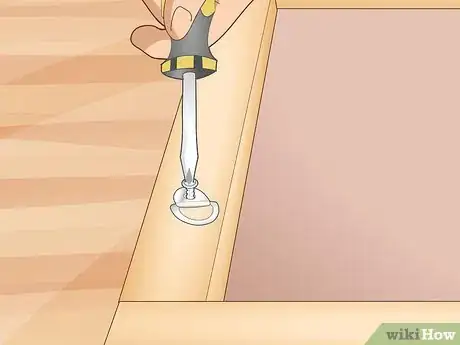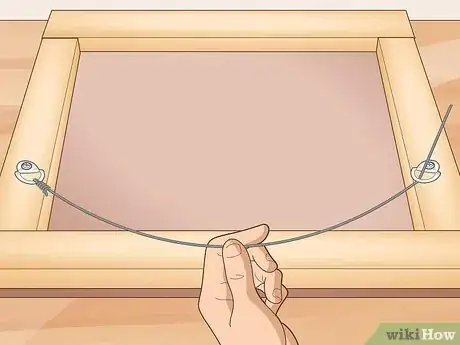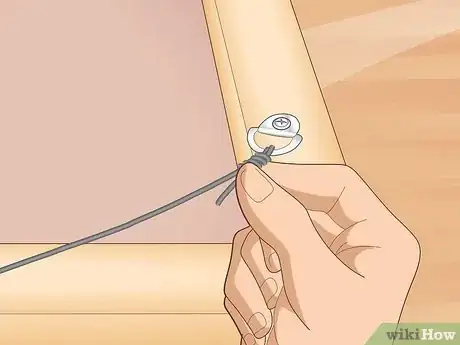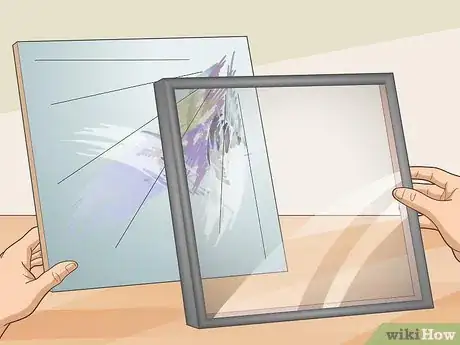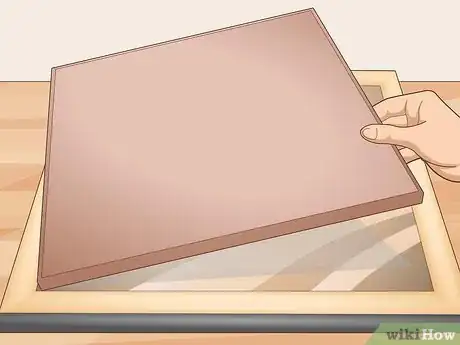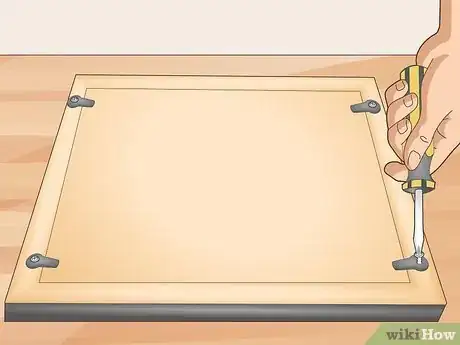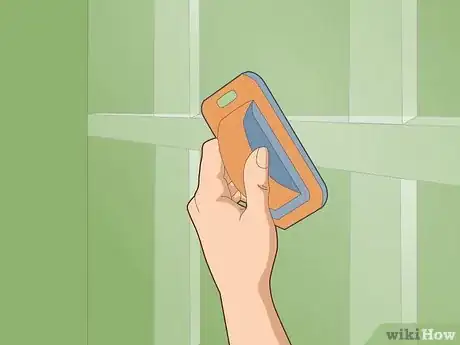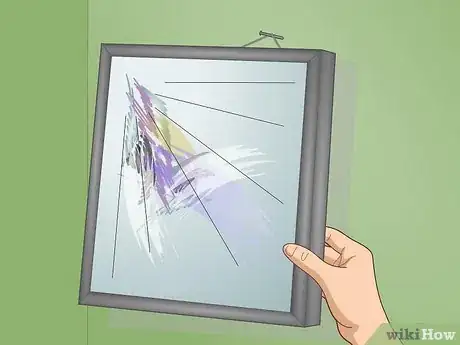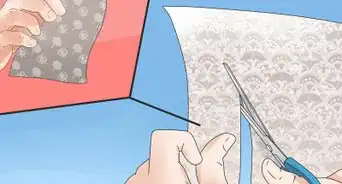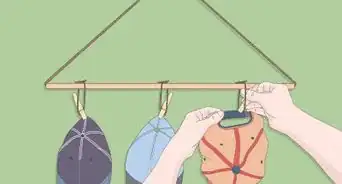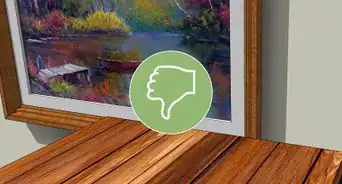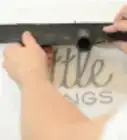This article was co-authored by Peter Salerno. Peter Salerno is the owner of Hook it Up Installation, a professional installation company, which has been hanging art and other objects around Chicago, Illinois for over 10 years. Peter also has over 20 years of experience installing art and other mountable objects in residential, commercial, healthcare and hospitality contexts.
There are 11 references cited in this article, which can be found at the bottom of the page.
This article has been viewed 20,705 times.
Masonite board is a type of hardboard that’s very popular with painters because of its light weight and smooth surface. It's also versatile, and you can paint directly onto it or use it to mount paintings on paper. Whether you paint your own pieces or picked up some Masonite paintings at the store, you’ll naturally want to display the art. Luckily, Masonite board is easy to hang on any wall.
Steps
Attaching Picture Wire
-
1Measure the dimensions of the painting. To hang Masonite without a frame, you’ll need to make a wooden border around the back of the board. The extra wood supports the screws, rings, and wire that hangs the painting. Start by measuring the length and height of the painting. Record those measurements so you don’t forget them.[1]
-
2Cut 2 strips of wood to fit across the painting’s top and bottom edges. Get strips of wood that are 1 in (2.5 cm) x 2 in (5.1 cm) in thickness and width. Mark the strips to match the length of the board. Then use a saw and cut the strips to fit that length.[2]
- Always wear gloves and goggles when using a saw. Keep your fingers at least 6 in (15 cm) away from the blade while it’s spinning.
- You could use thicker wood if that’s the only thing available, but the board won’t hang as close to the wall if you use thick strips.
Advertisement -
3Cut 2 more strips of wood to fit between the top and bottom pieces. Arrange the first 2 strips of wood along the top and bottom edges of the painting. Then measure the distance between the wood. Mark 2 more wood strips with this measurement and cut them with the saw.[3]
- For example, if there is 8 in (20 cm) between the wood, then cut the next 2 pieces so they're 8 in (20 cm) long.
-
4Glue the wood onto the back border. Squeeze a line of wood glue onto each strip of wood and use a brush to spread the glue around. Press each strip down onto the back of the board and hold it for 30 seconds.[4]
- Let the glue dry for at least 24 hours before trying to hang the painting. Otherwise the strips could come loose.
-
5Mark each side 1/3 of the distance down from the top of the painting. Take your ruler and measure the painting from top to bottom. Divide that measurement by 3 to break it into thirds. Make a mark on each side of the wood border 1/3 of the way down from the top.[5]
- For example, if the painting is 18 in (46 cm) in height, then make a mark 6 in (15 cm) from the top.
-
6Screw a D-ring into the mark on each side. D-rings are small rings that screw onto frames and boards to hang them up. Line up the D-ring holes with the marks you made and point the ring towards the inside of the board. Then screw it into place with a power drill. Repeat this on the other side as well.[6]
- D-rings come in different sizes and usually range from 1⁄2 in (1.3 cm) to 2 in (5.1 cm). Get something on the larger side to support the weight of the board best.
- D-ring kits should come with their own screws. If you don’t have the screws that came with the D-ring, don’t use screws longer than 1⁄2 in (1.3 cm) or you might punch through the board.
-
7Tie picture frame wire to one D-ring. Unroll about 3 in (7.6 cm) of picture wire and insert it into one of the D-rings from the inside of the board. Loop it up and wrap the string around itself, then insert it back into the ring. Loop it back out of the ring and wrap the remaining wire around itself to tighten the knot.[7]
- Keep the wire tight the whole time you’re tying it. Give it a pull if it gets slack.
- You can find picture frame wire at hardware or craft stores, or order it online. It comes in a roll like string.
-
8Cut the wire 4 in (10 cm) past the second D-ring. Unroll the wire across the board to the other D-ring and extend it 4 in (10 cm) beyond the ring. This allows you extra room to tie and loop the wire. Clip it off with wire cutters at this point.[8]
- You could also leave more than 4 in (10 cm) at the end of the wire to give yourself more room for error. You can wrap this excess wire around at the end or just clip it off.
-
9Leave the string slack enough to stretch just below the top of the board. Loop the wire through the D-ring and hold it in place, leaving it a bit slack. Then grab the string in the middle of the board and pull it up towards the top. Adjust the tightness as needed and make sure the wire rests just below the top of the board.[9]
- This height is important because if the wire is too tight, the board won’t be stable. But if it’s too loose, the wire and nail will show above the top of the painting.
-
10Tie the wire to the other D-ring. When you’ve found the correct tightness for the wire, then attach the wire to the D-ring. Repeat the same knot that you tied on the other side to secure the wire properly.[10]
- Test the wire before trying to hang the painting. Hold the frame by the wire to make sure it stays attached.
Framing the Painting
-
1Get a frame that fits the painting's dimensions. Use a tape measure or ruler and check the length, width, and height of the painting. Take your measurements to a hardware store or framing store and see what’s available. Get a frame that matches your board dimensions and complements the painting design. Employees at the hardware store can offer you design suggestions for the best type of frame.[11]
- The length and height of the frame are most important. If the frame is too thick and there is too much space inside it, you can fill it out with foam.
- You have many options for painting frames, ranging from plain to ornate. Try to get a frame that complements the painting itself rather than focusing on matching the furniture and decor in the room it will hang in.[12]
- There are multiple sizes for Masonite board. They range from 5 in (13 cm) x 7 in (18 cm) all the way up to 24 in (61 cm) x 36 in (91 cm). A common painting size is 18 in (46 cm) x 24 in (61 cm).[13]
-
2Lay the painting facedown inside the frame. Remove the frame backing and lay it face down on the floor or a table. Take the painting and insert facedown into the frame.[14]
- Most frames have latches along the edge that slide over and free the backing. In some cases, frames have screws that hold the backing down. Follow the procedure that your frame uses.
- You don’t need any glass or covering for a Masonite painting.
-
3Fill up any empty space with foam board to keep the painting in place. If the frame is too thick and the painting doesn’t take up all the space inside, it could rattle around and get damaged. Get some foam board from a hardware or craft store. Cut it to fit inside the frame and fill up any remaining space to protect the painting.[15]
- You could also use a similar cushioning material like Styrofoam to fill out the frame.
-
4Secure the backing onto the frame. With the painting and cushioning inside the frame, replace the back portion. Press it into the back of the frame and either replace the screws or slide the latches back into place to secure it.[16]
- Pick the frame up slowly to make sure the backing is attached. Keep it close to the floor and give it a very light shake to make sure the backing and painting stay in place.
Mounting the Board or Frame
-
1Find a stud in the location you want to hang the painting. When you’ve decided on a location for your painting, you’ll need a stud to support the board weight. Run a stud finder along the wall and locate the closest stud where you want to hang the painting. Mark this location with a pencil.[17]
- If you don’t have a stud finder, you can tap along the wall with a hard object like the back of a screwdriver. If you hear a hollow sound, then there is no stud there. If you hear a quick thud, you’ve found the stud.
- In average homes, studs are placed 16 in (41 cm) apart, and sometimes 24 in (61 cm).
-
2Drive a 2 in (5.1 cm) finishing nail into the stud at the height you want the painting. Measure the height that you want your painting to hang at and mark the point with a pencil. Then hammer a nail into that point, leaving enough sticking out for the board to rest on.[18]
- The standard painting height is 57 in (140 cm), because that’s where the average person’s eye level is. You can follow this guideline if you’d like.[19]
- In general, make sure the painting is far enough away from couches and high-traffic areas so no one will bump into it.
-
3Hang the frame or board onto the nail. Once the nail is in place, lift the board up to it. If the painting is in a frame, let the teeth on the back-clasp hook over the nail. If you’re using picture wire, let the wire rest on the nail and slide the board until the nail is right in the middle. Step back to make the board is level, then enjoy your new artwork.[20]
- Feel free to move the painting if you decide you want it in a different spot. Nails only leave small holes, so moving the painting around is no big deal.
Expert Q&A
Did you know you can get expert answers for this article?
Unlock expert answers by supporting wikiHow
-
QuestionHow far apart should I hang multiple paintings?
 Peter SalernoPeter Salerno is the owner of Hook it Up Installation, a professional installation company, which has been hanging art and other objects around Chicago, Illinois for over 10 years. Peter also has over 20 years of experience installing art and other mountable objects in residential, commercial, healthcare and hospitality contexts.
Peter SalernoPeter Salerno is the owner of Hook it Up Installation, a professional installation company, which has been hanging art and other objects around Chicago, Illinois for over 10 years. Peter also has over 20 years of experience installing art and other mountable objects in residential, commercial, healthcare and hospitality contexts.
Installation Expert
-
QuestionHow do you hang a painting on a brick wall?
 Peter SalernoPeter Salerno is the owner of Hook it Up Installation, a professional installation company, which has been hanging art and other objects around Chicago, Illinois for over 10 years. Peter also has over 20 years of experience installing art and other mountable objects in residential, commercial, healthcare and hospitality contexts.
Peter SalernoPeter Salerno is the owner of Hook it Up Installation, a professional installation company, which has been hanging art and other objects around Chicago, Illinois for over 10 years. Peter also has over 20 years of experience installing art and other mountable objects in residential, commercial, healthcare and hospitality contexts.
Installation Expert
-
QuestionCan you hang a painting on a concrete wall?
 Peter SalernoPeter Salerno is the owner of Hook it Up Installation, a professional installation company, which has been hanging art and other objects around Chicago, Illinois for over 10 years. Peter also has over 20 years of experience installing art and other mountable objects in residential, commercial, healthcare and hospitality contexts.
Peter SalernoPeter Salerno is the owner of Hook it Up Installation, a professional installation company, which has been hanging art and other objects around Chicago, Illinois for over 10 years. Peter also has over 20 years of experience installing art and other mountable objects in residential, commercial, healthcare and hospitality contexts.
Installation Expert
Things You’ll Need
Framing the Painting
- Ruler or tape measure
- Picture frame
- Foam board (if needed)
- Screwdriver
Using Picture Wire
- Wood glue
- Ruler or tape measure
- Pencil
- 1 in (2.5 cm) x 2 in (5.1 cm) wood strips
- Saw
- Gloves
- Goggles
- Picture frame wire
- D-ring set
Mounting the Board or Frame
- Stud finder
- Hammer
- Nail
- Ruler or tape measure
- Pencil
Warnings
- Always be safe when using power tools. Wear gloves and goggles, and keep your hands away from any moving parts.⧼thumbs_response⧽
References
- ↑ https://www.hyatts.com/pdf/ARTLMasonite.pdf
- ↑ https://www.hyatts.com/pdf/ARTLMasonite.pdf
- ↑ https://www.hyatts.com/pdf/ARTLMasonite.pdf
- ↑ https://www.hyatts.com/pdf/ARTLMasonite.pdf
- ↑ https://youtu.be/mdU0B8ov2Z0?t=77
- ↑ https://youtu.be/mdU0B8ov2Z0?t=101
- ↑ https://youtu.be/mdU0B8ov2Z0?t=159
- ↑ https://youtu.be/mdU0B8ov2Z0?t=217
- ↑ https://youtu.be/mdU0B8ov2Z0?t=237
- ↑ https://youtu.be/mdU0B8ov2Z0?t=252
- ↑ https://www.architecturaldigest.com/story/how-to-framing-art
- ↑ Peter Salerno. Installation Expert. Expert Interview. 10 June 2019.
- ↑ https://www.hyatts.com/pdf/ARTLMasonite.pdf
- ↑ https://www.architecturaldigest.com/story/how-to-framing-art
- ↑ https://www.hyatts.com/pdf/ARTLMasonite.pdf
- ↑ https://www.hyatts.com/pdf/ARTLMasonite.pdf
- ↑ https://www.architecturaldigest.com/story/our-guide-to-hanging-art-like-a-professional
- ↑ https://www.architecturaldigest.com/story/our-guide-to-hanging-art-like-a-professional
- ↑ https://www.popularmechanics.com/home/interior-projects/how-to/a3122/the-proper-way-to-hang-a-picture-10792209/
- ↑ https://www.architecturaldigest.com/story/our-guide-to-hanging-art-like-a-professional

